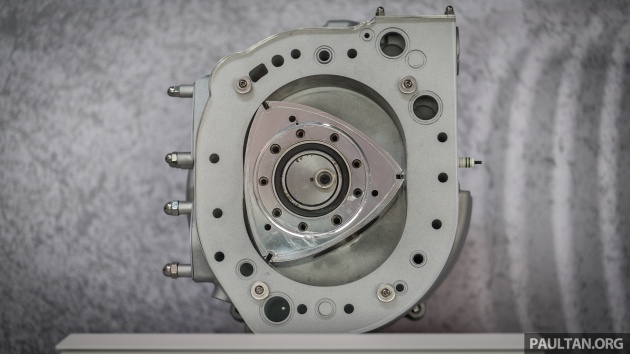Mazda has revealed that its iconic rotary engine will make a return. According to a report by Bloomberg, the Hiroshima-based automaker is reviving the classic technology for use in an unlikely place: battery-powered, self-driving vehicles that it’s developing with Toyota. The idea is to deliver everything from pizza to people, adds the report.
Mazda will provide rotary engines that function as generators to recharge the batteries for Toyota’s driverless delivery fleet, said Masahiro Moro, president of Mazda North America in an interview. He added that the self-driving vehicles are currently in development.
“This is a very suitable engine to run a generator because it’s compact and lightweight, with no noise or vibration, and it has very good fuel economy,” said Moro at the 2018 North American International Auto Show in Detroit.
Rotary engines require only a handful of parts to perform the burning of fuel and removal of exhaust inside a single combustion chamber, while traditional engines use a number of pistons, valves and crankshafts to coordinate these tasks in multiple chambers. Even after decades of trying to perfect the technology, Mazda somehow couldn’t lower emissions from its rotary-engined sports cars enough to satisfy regulators, so production and sales stopped altogether.
The Mazda rotary engines will not be the primary provider of propulsion, though. Instead, Toyota will use it as a range extender, a combination that General Motors first mass marketed in its 2011 Volt, although it had an inline-four engine instead of a Wankel/rotary.
The vehicles, which Toyota said would be developed with partners including Amazon, will need lots of electricity because Toyota plans to customise them to function as everything from mobile emergency command posts to traveling hotel rooms. Together, Toyota and Mazda (the former has a 5.25% stake in Mazda) will be building a new RM6.3 billion, jointly run vehicle assembly plant in Huntsville, Alabama.
Denso, a company which Toyota has a controlling stake in, is also helping develop engines and mechanical underpinnings for the electric cars that Toyota and Mazda are developing together, said Moro. “The companies are studying, among other things, whether to use rotary engines as range-extenders on more than just the e-Palette self-driving delivery vehicle,” said Toyota spokesman Brian Lyons.
Previously, Mazda’s global powertrain boss Mitsuo Hitomi told Automotive News last October that a range extender is a necessity in North America because people there typically drive for a much longer distance. Interestingly, Hitomi also said that a second, larger and more powerful rotary engine is currently being developed for a high-performance sports car that will slot above the MX-5.
Looking to sell your car? Sell it with Carro.





























Mazda and Toyota make great cars. But don’t worry if you cannot afford a Toyota. The secret is, buy the 2018 Perodua Myvi. It uses the same Toyota VVTI engine as the RM90k Toyot Vios.
In other words, you are buying a Toyota for RM50k.
(Like) Perodua Myvi 2018
(Dislike) Toyota Vios 2018
Perodua Kembara 1.5T 2018.
Toyota and Mazda, the Auto unicorns!
It’s a Wankle engine not a Wankey engine Matthew…
first pioneered by GM in 2011? hello! let me explain there are basically 2 hybrid set-up types namely
1. Series type (like previos Civic Hybrid or Insight where a motor is in tandem with the engine to increase power output without increaseing CO2.
2. Parallel type, where there is a motor generator to charge the battery while its on the move. also known as range extender. examples are Chevrolet Volt @ Vauxhall Ampera and Proton Saga REEV.
3. Parallel-series. This was what developed by Toyota in the 90s in the first model of Prius. its combination of both systems mentioned above, now even Honda City Hybrid and Hyundai Ioniq are applying a similar system.
and to say Chevrolet was the pioneer is a bit misleading because in 2010, Top Gear UK trio had created/engineered a vehicle known as Hammerhead Eagle i-thrust ‘Geoff’ using chassis of TVR Cerbera and electric motor of a milk delivery van.
You’re right. Mass-marketed by GM is more accurate.
Have they resolved the excessive fuel consumption and oil leakages?
Rotary engine = good FC? Really I thought it was the opposite.
Yeah, I thought rotary engines are required to be rev in high RPM? Also, as mentioned by someone, what about the maintenance of the apex seal and lubricant consumption?